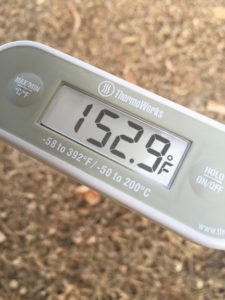Temperature: An Essential Ingredient for any Quality Compost Pile
Temperature is an essential component of any quality compost pile. As organic matter decomposes energy is released, which results in an increase in heat. This heat provides an environment wherein bacteria (good bacteria) can work to break down waste.
Just like the food we eat, there are target temperatures for compost that make it both safe and productive. A compost that’s too cool is at risk of contamination. If we allow compost to get too hot we hinder bacterial growth and stop the effective breakdown of organic matter.
Monitoring these temperatures, controlling the release of unwanted heat or adding organic matter to increase heat is key to ensuring your compost is free from potentially harmful pathogens and produces quality compost.
Below 135°F, compost is considered too cool. In fact, eggs of parasites, cysts and flies have been known to survive for days in this relatively cool environment. At these temps bacteria works more slowly, which can result in the transformation of an aerobic (oxygen rich) compost into an anaerobic (oxygen depleted) breakdown.
[Tweet “Below 135°F, compost is considered too cool. In fact, eggs of parasites, cysts and flies have been known to survive for days in this relatively cool environment.”]
When oxygen is removed from the decomposition equation the breakdown of matter happens at a much slower rate. This means it may take upwards of a year before you’re able to harvest any quality compost. If cool temperatures persist, you need to get bacteria active – stat! Their activity will release heat into the pile and induce continued breakdown.
Start by adding nitrogen-rich “green” organic material. Your brown-to-green ratio should be about 4-to-1. That’s four parts dried leaves to one part grass clippings or vegetable scraps. Next, add moisture to the pile to induce activity. Studies have shown a significant correlation between the moisture content and the temperature distribution within the pile. When moisture content is high, temperatures near the surface will be higher.
Above 160°F, compost is too hot. Few thermophilic organisms are able to get much done when their environment is too hot. If left above 160°F, bacteria will cease active decomposition, which in turn will render the pile inert.
[Tweet “Above 160°F, compost is too hot. Few thermophilic organisms are able to get much done when their environment is too hot.”]
To cool off a pile, give it a few turns with a pitch fork to allow heat to escape. If after a few hours temperatures start to creep back up, check your ratios of green to brown matter. Add more dried leaves to slow down the bacteria.
If you had to set a target temperature for your compost pile it would be 150°F. Above 135°F where pathogenic organisms struggle for survival and below 160°F where temperatures become too hot for bacteria to work properly.
[Tweet “If you had to set a target temperature for your compost pile it would be 150°F.”]

Suspicions of high or low temperatures can be quelled, or confirmed using the Min/Max feature that recalls the highest and lowest temperatures reached since the last reset. Leave the thermometer in place and come back to find out what happened while you stepped away. With a 5,000 hour battery life you can be confident that the thermometer won’t quit on you.
When maintained at your target temperature you should be able to harvest your compost in only 4-6 months – just in time for Spring. Good, quality compost will energize the soil and add rich nutrients to your garden. With a compost pile you’ll be able to enhance your garden’s ability to grown healthy plants while reducing your volume of trash.
__________________________________________________________________
Resources:
Washington State University – Compost Fundamentals
Bonnie Plants: Composting 101 – What is Compost?
Gardening Know-How: Heat and Compost – Heating Up Compost Piles


The RT610B is cool and all, but it doesn’t seem to allow for remote monitoring and data logging. That’s the reason why I opted instead to purchase a competing compost thermometer solution. Let me know when you’ve got something like that available.
If you want remote monitoring and logging for your compost, you may be looking for our NODE thermometer! Node connects to wifi, has high- and low- temperature alarms, and will record data that you can access via cloud.thermoworks.com or via our free app. We market it mostly as a fridge-monitoring tool for restaurants who need to know if their walk-ins go down and also need to be able to show their inspectors their temperature logs. BUT I use mine for monitoring day/night temperature swings in my workshop, and with a 12″ Pro-Series probe, you could easily monitor your compost. You choose how often it records data, and how often it transmits data, so you can get the granularity you want. It’s rated to IP66 so it’s weatherproof, and I leave mine outside all winter in Utah.